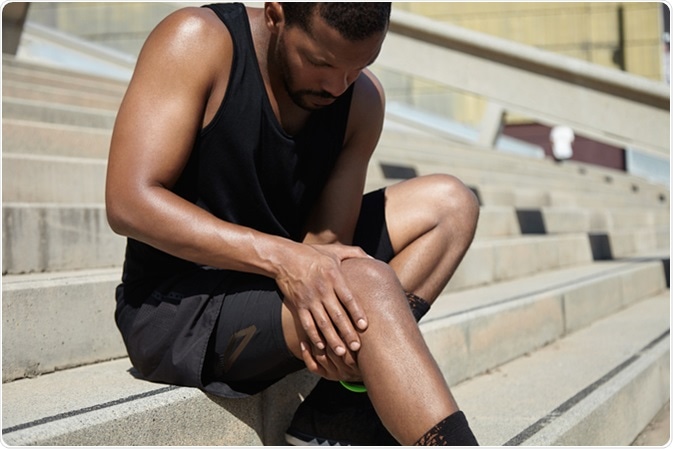
How to Reduce Muscle Soreness After Training
When exposed to intense or unaccustomed exercises, muscles tend to get sore. This occurrence is normal and expected for any person who engages in grueling physical activities. Typically termed delayed onset muscle soreness (DOMS), this common medical condition peaks 24 hours to a maximum of 72 hours after engaging in exercise or physical activity. The process is common among people of various age groups and is backed by multiple researches; however, what many people do not understand is that muscle soreness is actually an inflammatory response caused by the breakdown of muscle tissue.
Emerging research within sports science and physiology has discovered how this seemingly common phenomenon of muscle soreness can be reduced or prevented. Findings include the use of various methods, including foam rolling, stretching, and even getting a massage.

Image Credit: WAYHOME Studio / Shutterstock
Foam Rolling
Delayed onset muscle soreness is a type 1 muscle strain that produces muscle tenderness. Interventions in physical therapy could therefore be integrated post-exercise to reduce DOMS. An example of this is foam rolling, a process where individuals utilize their own body weight in order to exert pressure on the soft tissue. The friction created by the foam roller reduces pressure in the tissue and further reduces muscle soreness.
A study was conducted in order to examine the effectiveness of foam rolling as a recovery exercise to reduce muscle soreness. The research found that a 20-minute bout of foam rolling, immediately after exercise, on a high-density roller, and every 24 hours could indeed reduce muscle soreness and tenderness. This finding is consistent with a previous studies) that assert the benefits of foam rolling post-exercise.
Getting a Massage
As a prominent therapeutic measure to prevent muscle damage, massaging is widely used as a model for treating DOMS or any muscle damage brought about by strenuous exercise or physical activity. Several studies have attested to the effectivity of such method; in particular, research which concluded that a 30-minute therapeutic massage per leg after two hours of downhill running was effective in limiting DOMS. Meanwhile, further studies have concluded that coupling massages with stretching and warm-up activities could significantly reduce muscle soreness.
While massages are empirically proven to reduce DOMS, the method is still coupled with controversy due to the various exercise models that are available.. In addition to this, is the varying physiological response of individuals to physical activity.
The Misconception About Stretching
In many physical activities, stretching is facilitated in order to avoid any potential injuries and to ready the muscles for an upcoming blow of intense activity. However, it is argued that stretching is an unreliable method in alleviating and reducing muscle soreness post-workout. An empirical review of 12 randomized controlled trials which all investigated the usability of stretching, found that the activity posed little to no effect in improving muscle soreness even a week after the exercise.
While athletes and active individuals continue to use stretching within their routine, such methods may not effectively alleviate muscle soreness. Despite this, stretching could serve other functions, such as avoiding injuries which could be deemed salient in exercise.
Taking Antioxidants
Older studies within sports science have highlighted the potential use of antioxidants as a method for reducing muscle soreness. This hypothesis has led contemporary researchers to examine the usability of antioxidants in such process. In 2017, an empirical review of 50 studies examining antioxidant use and application was conducted.. All studies varied in terms of type and dosage, but all utilized antioxidant supplementation for a specified time period.
The results of the in-depth analysis suggest that high doses of antioxidant supplementation could slightly reduce muscle soreness at up to six hours and after 24-hour intervals post-training. This finding, however, was not greatly significant and effects were only minute. Among the 50 examined studies, nine were also found to have adverse negative health effects such as diarrhea. These results pose doubts about the actual effectivity and safety of antioxidants in reducing muscle soreness, but research is continuously being undertaken at present to determine more data about these variables.
Sources
- Antioxidants for preventing and reducing muscle soreness after exercise. British Journal of Sports Medicine. https://bjsm.bmj.com/content/early/2018/07/27/bjsports-2018-099599
- Stretching to prevent or reduce muscle soreness after exercise. Cochrane database of systematic reviews (Online). www.researchgate.net/.../51473281_Stretching_to_prevent_or_reduce_muscle_soreness_after_exercise
- Effects of Massage on Delayed-Onset Muscle Soreness, Swelling, and Recovery of Muscle Function. Journal of Athletic Training. https://www.ncbi.nlm.nih.gov/pmc/articles/PMC1250256
- Foam Rolling for Delayed-Onset Muscle Soreness and Recovery of Dynamic Performance Measures. Journal of Athletic Training. www.ncbi.nlm.nih.gov/pmc/articles/PMC4299735/#i1062-6050-50-1-5-b14
- Muscle tenderness from exercise: mechanisms? The Journal of Physiology. https://www.ncbi.nlm.nih.gov/pmc/articles/PMC1456053/
Further Reading
Last Updated: Oct 22, 2018





















.jpg)










No hay comentarios:
Publicar un comentario